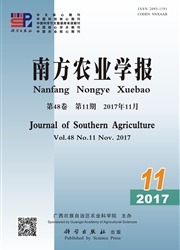

 中文摘要:
中文摘要:
【目的】探讨不同土地利用对钙(Ca)形态的影响及其引起的p H、有机碳差异,为揭示植被对岩溶生态系统中Ca循环的影响及合理利用土地提供参考。【方法】分别在岩溶区林地、灌丛、草地、果园4种不同土地利用类型中,采集0~70 cm的土壤样品,分析不同土地利用类型及深度土壤p H、有机质及Ca形态的特征。【结果】林地的p H、有机碳及酸溶态Ca、可还原态Ca、可氧化态Ca、残渣态Ca均显著高于其他土地利用类型(P〈0.05);4种土地利用类型中的Ca均以酸溶态为主,占总量的50%以上,其次是可还原态,占30%以上,可氧化态及残渣态相差不明显,约占总量的20%。4种土地利用类型不同形态的Ca均与p H呈极显著正相关(P〈0.01,下同),除残渣态外,其他3种形态的Ca与有机碳也呈极显著正相关。【结论】不同土地利用方式显著影响了土壤Ca总量及其形态分布,其中林地显著高于果园、草地、灌丛,更有利于有机质的积累。
 英文摘要:
英文摘要:
[ Objective ]The effects of different land use types on soil calcium(Ca) fraction and the caused differences in pH and organic carbon were investigated, in order to provide reference for revealing influence of vegetation on Ca cycle in the karst ecosystem and using rationally land. [Method]The soil samples at the depth of 0-70 cm were collected from woodland, shrub, grassland and orchard. The characteristics of pH, organic carbon and Ca fractions in different depths of different land use type soils were analyzed. [Result]The results showed that pH, organic carbon and acid-soluble fraction, reducible fraction, oxidable fraction and residual fraction of Ca in the woodland were significantly higher than those of other three land use types. Furthermore, the Ca in four land use type soils was dominated by acid-soluble fraction, which accounted for above 50% of total Ca, followed by reducible fraction accounting for more than 30% ; the oxidable and residual fractions together accounted for 20%, and there was no significant difference between oxidable fraction and residual fraction. In addition, as for four land use types, all Ca fractions were extremely significantly positive correlated with pH (P〈 0.01 ,the same below). And excepting residual fraction, three other fractions were extremely significantly positive correlated with organic carbon. [ Conclusion ] Different land use types significantly influence soil total Ca and its fraction distribution. Furthermore, the organic carbon content in woodland was higher than those in shrub, grassland and orchard, respectively, suggesting that woodland is more beneficial for accumulation of organic matter.
 同期刊论文项目
同期刊论文项目
 同项目期刊论文
同项目期刊论文
 期刊信息
期刊信息
